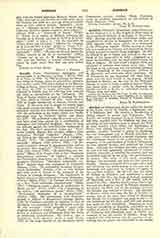

Anschar (or ANSGA UUS), Saint, called the Apostle of the North, was b. in Picardy, September 8, 801; d. February 5, 865. He became a Benedictine of Corbie, whence he passed into Westphalia. With Harold, the newly baptized King of Denmark who had been expelled from his kingdom but was now returning, he and Autbert went to preach the Faith in that country where Ebbo, the Archbishop of Reims, had already labored but without much success. Anschar founded a school at Schleswig, but the intemperate zeal of Harold provoked another storm which ended in a second expulsion, and the consequent return of the missionaries. In the company of the ambassadors of Louis he Debonnaire, he then entered Sweden, and preached the Gospel there. Although the embassy had been attacked on its way and had apparently abandoned its mission, Anschar succeeded in entering the country, and was favorably received by the king, who permitted him to preach. The chief of the royal counsellors, Herigar, was converted, and built the first church of Sweden. Anschar remained there a year and a half, and returning was made bishop of the new see of Hamburg, and appointed by Gregory IV legate of the northern nations. He revived also the abbey of Turholt in Flanders, and established a school there. In 845 Eric, the King of Jutland, appeared off Hamburg with a fleet of 600 vessels, and destroyed the city. Anschar was for some time a fugitive and was deprived also of his Flemish possessions by Charles the Bald, but on the accession of Louis the German was restored to his see. The bishopric of Bremen which had been the See of Leudric, his enemy, was at the same time united to Hamburg, but though the arrangement was made in 847 it was not confirmed by the Pope until 857, and Anschar was made the first archbishop. Meantime he made frequent excursions to Denmark, ostensibly in the quality of envoy of King Louis. He built a church at Schleswig and afterwards went as Danish ambassador to his old mission of Sweden. King Olaf regarded him with favor, but the question of permitting him to preach was submitted to the oracles, which are said to have given a favorable answer. It was probably due to the prayers of the saint. A church was built and a priest established there. In 854 we find him back in Denmark, where he succeeded in changing the enmity of King Eric into friendship. Eric had expelled the priests who had been left at Schleswig, but at the request of Anschar recalled them. The saint built another church in Jutland and introduced the use of bells, which the pagans regarded as instruments of magic. He also induced the king to mitigate the horrors of the slave-trade. He was eminent for his piety, mortification, and observance of the monastic rule. He built hospitals, ransomed captives, sent immense alms abroad, and regretted only that he had not been found worthy of martyrdom. Though he wrote several works, very little of them remains. He had added devotional phrases to the psalms, which, according to Fabricius, in his Latin Library of the Middle Ages, are an illustrious monument to the piety of the holy prelate. He had also compiled a life of St. Willehad, first Bishop of Bremen, and the preface which he wrote was considered a masterpiece for that age. It is published by Fabricius among the works of the historians of Hamburg. Some letters of his are also extant. He is known in Germany as St. Scharies and such is the title of his collegiate church in Bremen. Another in Hamburg under the same title was converted into an orphan asylum by the Lutherans. All of his success as a missionary he ascribed to the piety of Louis le Debonnaire and the apostolic zeal of his predecessor in the work, Ebbo, Archbishop of Reims, who, however, as a matter of fact, had failed.
T. J. CAMPBELL

